When Big Brother Is Your Boss
06 Jul 2021
Today we share excerpts from an oral history interview conducted with Marceline Donaldson, who worked at IBM in the 1970s and experienced firsthand the oppressive culture that persisted in the face of the company’s integration efforts. Donaldson delves into the mechanisms that IBM used to dilute worker power as well as her steps toward forming a union, which led to IBM’s retaliation against her.
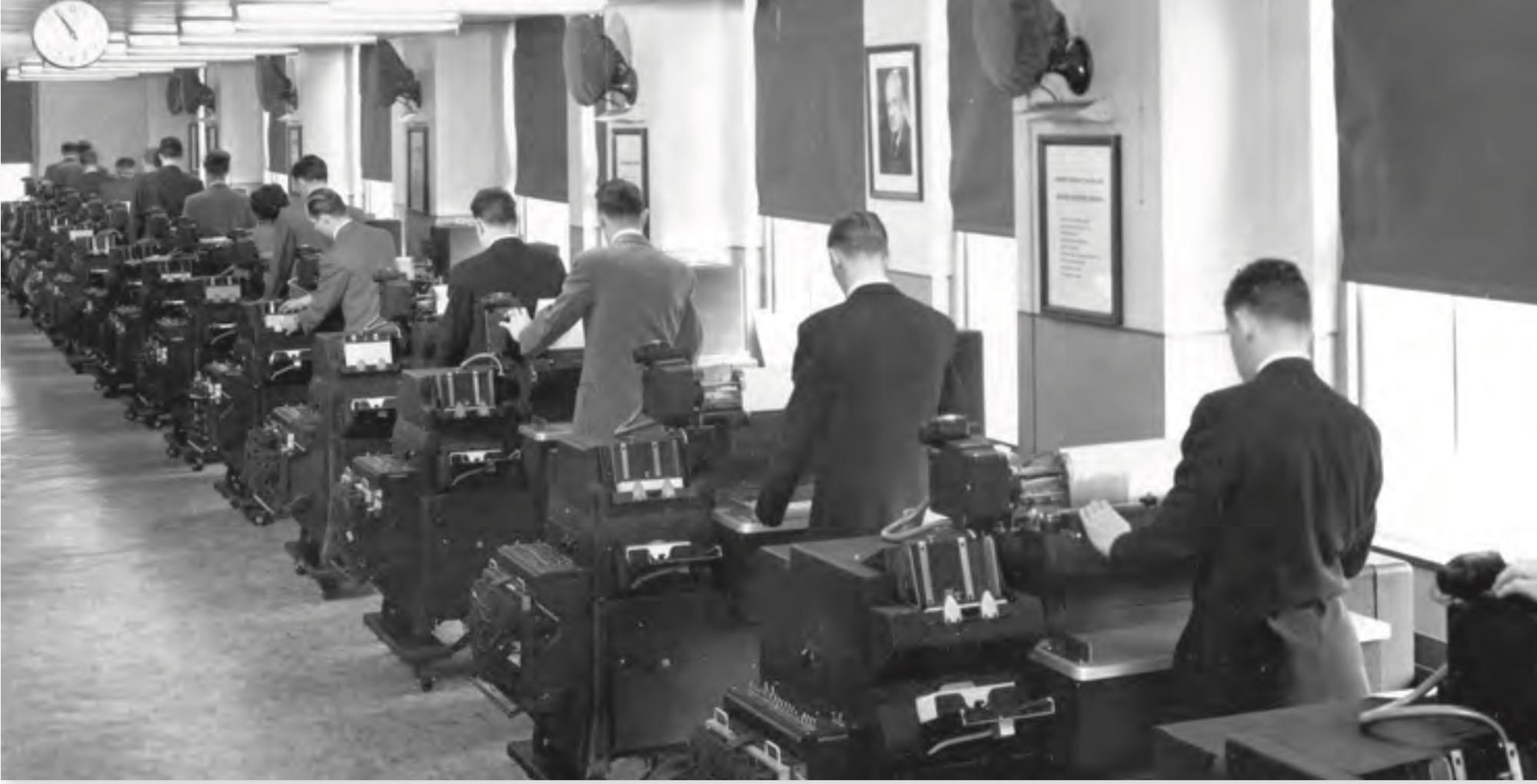
IBMers operate a row of Alphabetic Tabulators as a portrait of Thomas Watson Sr. watches over them. / Source
The Worker’s Perspective
by ann haeyoung
Marceline Donaldson worked at IBM in the Sales division from 1976-1979. Prior to IBM, Donaldson worked at Pillsbury and filed a suit against the company for race and sex discrimination. The suit was supported by the NAACP Legal Defense Fund and taken to the Supreme Court. After a grueling case, she was forced to settle. She has continued her organizing work since then.
During her time at IBM, Donaldson tried to bring in the Pullman Porters to unionize IBM employees. Her efforts made her a target for retaliation from the company, and she ultimately filed a discrimination case with the NLRB and was fired by IBM for her organizing efforts. Donaldson echoes many of the grievances voiced by Dr. Richard Hudson of the IBM Black Workers Alliance in the first interview in this series. Like Dr. Hudson, Donaldson explains how a system set up to reward only a select few is fertile ground for building worker solidarity. She also notes that the political climate of the early Reagan years made it difficult to obtain legal support for her organizing efforts. Nevertheless, her commitment to helping her fellow workers and community continued throughout her time at IBM and beyond.
After IBM, Donaldson went on to seminary and was also on the national board for the National Organization for Women (NOW). She later founded a network of bed & breakfasts called Bettina Network, which she has been running since the mid-1980s – a continuation of her legacy as a lifelong entrepreneur and community builder.
Marceline Donaldson outlines her groundbreaking career and organizing leading up to her time at IBM.
Prior to IBM, the college I attended was New York University. I left NYU and moved to Minneapolis, Minnesota because my husband at the time went to work for Honeywell. In Minnesota, I attended the University of Minnesota in the School of Design and went through about three years in their graduate program of design. After the University of Minnesota, I started Ma-Li-Kai, an antique auction gallery, interior design studio, and antique shop. And, as my life has dictated, I was the first Black female auctioneer in the country and probably also the first female.
After Ma-Li-Kai, I was hired by Dain, Kalman, & Quail, Inc. — a stock brokerage firm — as a stockbroker. Again, first Black female. I worked there for several years and moved from Dain, Kalman, & Quail, Inc. to Harvard Business School. From Harvard I was hired by The Pillsbury Company, Inc. as their first female manager who was not over the kitchen or the typing pool. I applied in International Marketing. Looking back over that time, the management must have had a good laugh at that because International Marketing was an all-white, all-male boys club.
I was told that Pillsbury hired management people who first worked in Personnel and then were moved into the area of their choice. So, to work in International Marketing, I would first need to work in Personnel, understand the company from that perspective, and after six months or more, I could be moved into International Marketing. Well, that was a myth. As a Black female, the only choice was Personnel and there they hoped I would stay.
I pushed constantly to be moved into International Marketing, outlining all the reasons why the Personnel thing was bogus. I was finally transferred. That transfer came basically because I began to recognize the racist/sexist structure at the company and outlined it for all to see. The Chairman and CEO at the time was Bob Keith, who was at the end of a terminal disease. He wanted to see that kind of change happen and supported the work I was doing. Because I had access to the Chairman’s Office, that was not a good thing from the white male perspective, but it was a good thing amongst the women and minorities.
I organized women and minorities into a group which met for lunch weekly to talk about their jobs: where their problems were; how they could be addressed; which were changeable and which were not. After the company freaked out about all of this, someone contacted the Civil Rights Division of the U.S. and we were off to the races. Clarence Thomas was head of the agency at the time. Looking back at what happened there, it was not possible for any good changes to come out of that. I wound up suing Pillsbury for race and sex discrimination. That case went on for some 13 years and went to the United States Supreme Court. I also jointly organized a boycott against General Mills with the National Urban League while serving on the board of NOW, the National Organization for Women.
At the end of that, I went to work for IBM.
Donaldson discusses the dissonance between her preceding perceptions of IBM and the reality that she came up against.
From what I knew and heard about IBM, I thought this was going to be a great place to work. In reality, IBM turned out to be more difficult — which means more racist and sexist — than all the rest because it had a structure in place which was horrific and which not only oppressed you because you were a minority and your work was not viewed outside of that context, but you were demeaned in the way the company oppressed everyone. “Big Brother” did not fire anyone. That was its reputation. They didn’t have to — you were put into a horrific position which forced you to resign. Quietly, with some dignity, although everyone knew you had actually been fired.
Donaldson shared a number of stories about IBM’s monoculture and how they enforced cultural norms with workers. Here, she speaks on IBM’s famous blue suit dress code for their salespeople. To enforce these corporate norms, IBM required all new salespeople to attend two 6-week training courses during which they would have to take a class called “Dress for Success.”
IBM had everybody wear blue suits. You had to wear a blue suit and a white shirt or a very pale blue shirt with a properly conservative tie. They told you straight out that you had to wear blue suits because people starting out at IBM don’t always have a lot of money, and if you buy a cheap blue suit, it looks a lot better than a cheap brown suit or a cheap gray suit.
And as far as the women were concerned, I don’t think there were five of us in this class of a hundred and some. You could wear whatever you wanted as long as it was subdued — and it was a suit.
Now, I was raised in the Deep South. In spite of Harvard Business School and all the rest of it, I wore dresses. I continued to wear dresses because I couldn’t afford to go out and buy suits. I had a whole wardrobe that my grandmother constantly made for me since she was a modiste and she’d send me all of these gorgeous dresses. That’s what I wore.
So when it came to Dress for Success, they told us to wear suits. They’re looking at me, telling me about how great it was to wear a two-piece suit and how that’s what IBM expected. When we got to the day before graduation at the end of this class, several of us got together and decided this would be Dress for Success day on the other side. So I went to class in a muumuu, which was popular at the time, and my hair up in these big curlers. The guys went with their jockey shorts over their suit pants and their undershirt out over their jacket.
IBM was not pleased. But the rest of the class thought that was just great and a comment needed on that Dress for Success class. Because [the class] was an insult to everybody taking it.
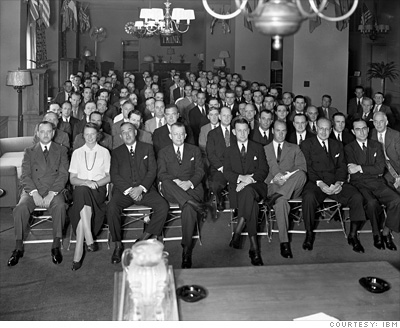
IBM salespeople in blue suits. / Source
Although IBM made efforts to integrate the company, Donaldson encountered deep-set resistance to recognizing the potential of Black workers, particularly when it came to roles that offered upward mobility.
Today, at 83 years old, I am just beginning to understand racism and sexism in terms I just didn’t back then. IBM was not looking for success in Blacks. They were looking for Blacks to work in support services. They were not looking for success in Blacks, especially a Black woman, in sales — because in sales, an employee has the opportunity to move up the corporate chain to CEO. That is, or was, the way up in most corporations. In support services, it was practically impossible to move up the chain of command.
I recognized the structure from Harvard Business School, which had taught me the differences. At IBM, support services included administration and systems engineering. To move up into management — to have a chance at that top job — you had to transfer out of the support area into sales.
Blacks were hired — although not many — in support services. IBM did not want Blacks in the line of succession up to the top of the company. I was hired through a Black “Executive” Agency which worked with IBM, and they told me going in that they had no success getting Blacks hired in sales. I had no success working in support areas so they pushed my candidacy for sales. Since I had a background in sales, IBM would have had a very difficult time explaining why, with job openings in sales and the commitment they said they were making through this Black-owned “Executive Agency,” they would do otherwise.
When I hit 140% of my sales quota the first year I started selling, life became very difficult. They did not go crazy with happiness over my success nor were there joyful celebrations. They went crazy because if I kept that up, I would be in line for the next step, which was management over a sales group. They were not going to put a Black woman over whites in those years.
IBM created a sales structure that conveniently benefited the employees they wanted to keep, while creating barriers for workers they sought to push out or subjugate. Donaldson recalls how her interrogation of the system led IBM to paint her as the problem.
As a salesperson at IBM in those years, you were given a “territory.” It could have been a geographical one, or it could have been a “territory” in a particular area of business. Every time I sold a computer, I was supposed to receive a commission. “Supposed to” is an accurate description because that didn’t often happen. In your territory, on paper, you received a commission. However, in your territory, any computer coming out — for example, a company returning a computer to IBM — the commission IBM paid to the salesperson who originally put the computer into the company now returning the computer was subtracted from your income.
If the computer you sold was replacing a computer sold to that particular company some 20 years ago, you were charged the commission originally paid, but in today’s dollars. Even if you were not the salesperson who originally placed the 20-year-old computer, that was irrelevant. It was a computer coming out of your territory, and so it was your responsibility to pay back to the company the commission it originally paid.
This policy was key to how IBM was able to very successfully manipulate its salespeople. The salespeople they wanted to move up, IBM could manipulate the territory so you had good money coming in — you looked like an excellent salesperson, you were one of the golden-haired boys, and you were cleared for ascent. If, however, they did not want you to move up, or if they wanted to move you out of the company, your territory reflected that. More often than not, that was done with many computers in your territory falling out.
IBM had very few minorities and almost no Blacks in sales at the time. When I came along with my 140% of sales quota record and asking questions about this way of compensating its salespeople, especially me, I began to be seen as a negative influence.
As I talked to other salespeople, I met one guy who was leaving the company because he owed IBM over $10,000. I could not connect to that because he was a very good salesperson. His sales record was excellent — until you subtracted from his sales the commissions someone else received from IBM which he was now expected to repay.
I kept talking about how he should be over the moon with his commissions. He was selling very well, how come he owed the company so much money? He said he could not keep up with machines falling out. When he sold a computer, there was always the computer the company purchased years earlier and the commission from that computer was being deducted from his commissions, leaving him with a bill of some $10,000.
What began to be clear to me was that if the company wanted to keep you but wanted to control you, they would negotiate and make you think they were giving you something wonderful. They would make you think you owed them because they were forgiving some of your computers being returned to the company, making your paycheck look very good and your standing in the company also very good.
On IBM’s paternalistic preoccupation with company loyalty and the challenge of organizing.
That way of compensation was institutionalized into IBM’s structure. You did what you could do for IBM. Most people were glad to do it because they felt that was promoting their career. People who were unhappy were people who were promoting their career, but something would happen to make them realize they may be promoting their career, but the company was not reciprocating. They were especially unhappy by the way their ability to support their families was being truncated in what looked like greed and a few more unpleasant concepts. These were the people who wanted to talk about creating and joining a union at IBM.
While these folks were ready to talk and saw the need for a union, they would be scared to take action. I am not sure where that fear originated. Afraid of losing their income and not being able to get another job? They were not, however, ready to challenge the company and they did not stop giving to IBM — and you gave a lot. I made quota, and by a substantial amount. I was rewarded with two things — I got to go to the IBM country club and I was invited into the IBM 100% club which meant my way to the IBM Conference was paid by the company.
The IBM country club was a bit of a disappointment. It was structured to develop loyalty such as I had not seen before.
When I arrived, one of the first things I saw were these songbooks. IBM songbooks. In the morning you didn’t say prayers over your breakfast, you sang IBM songs. Everything was geared to cultivating that kind of loyalty which can make many people lose perspective and get lost in the community identity all of this was geared up to create.
All of this developed a very beholden culture. You were beholden to IBM. It was developed in ways to make you feel you owed them. That carried into making you feel they were taking care of you the way a parent would. The mentality was of the great white father looking out for you. IBM was excellent at developing that kind of culture.
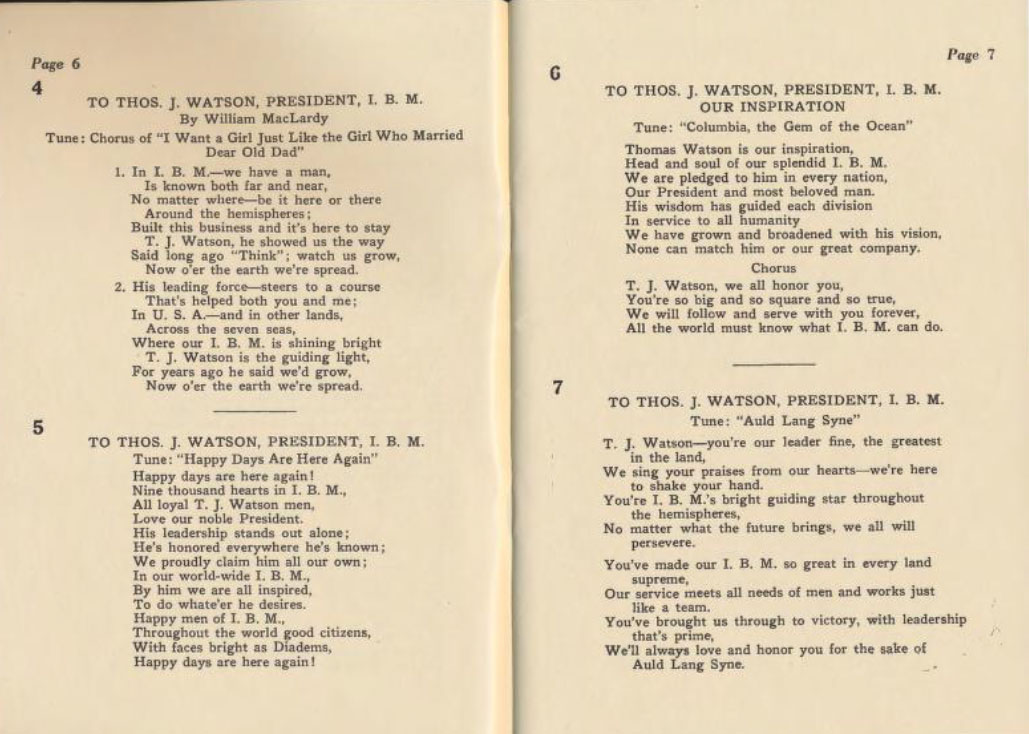
Some selections from the IBM songbook. / Source
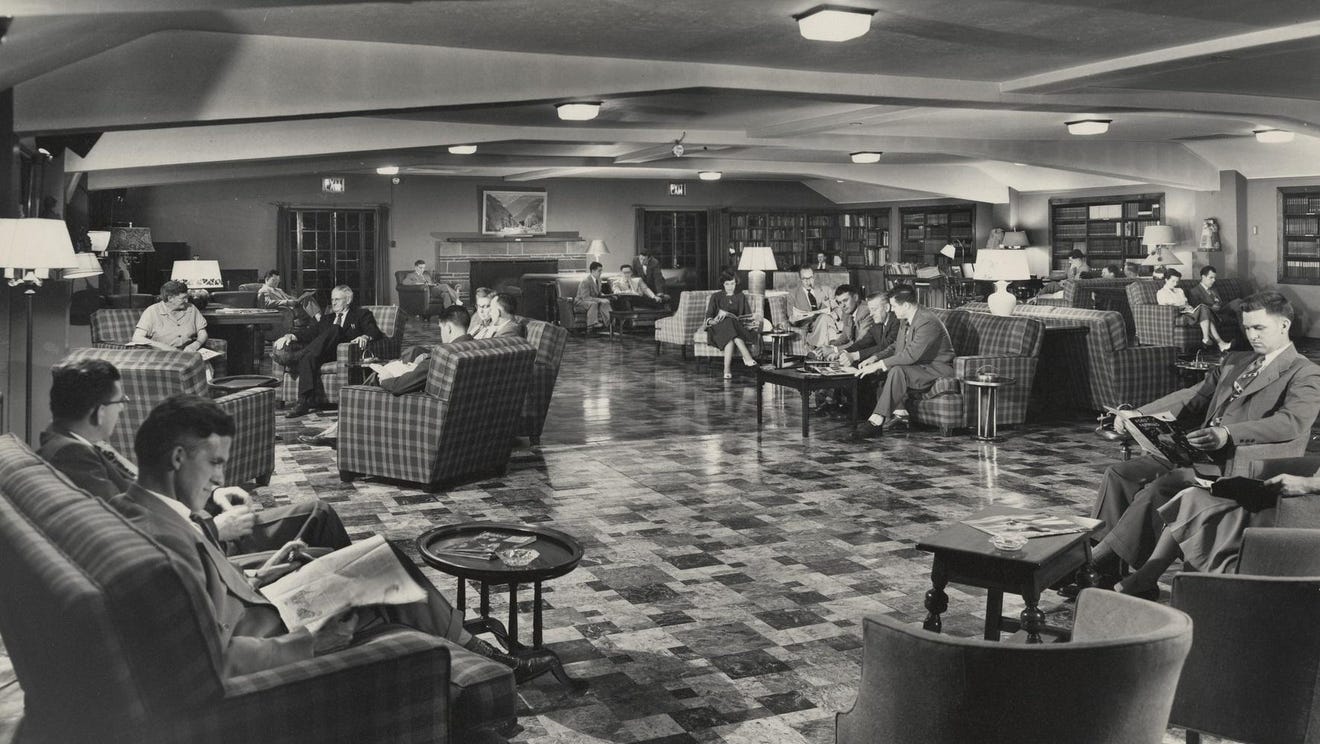
IBM country club. / Source
Donaldson describes IBM’s “constructive firings”, aka the involuntary attrition program, and the way employees often felt unreasonably indebted to the company. She connects these cultural phenomena to the need for a union.
Another part of that culture was the comfortable feeling that IBM — your company — did not fire people. In reality, we would call that a “constructive firing.” You would not be fired, you would quit because the company put you into such an untenable position you had to quit to be able to feed your family — like the guy who wound up owing the company some $10,000, but the company would magnanimously cancel the debt if he quietly resigned. He worked hard for IBM and had a good result. Something about him the company did not like, but even in this constructive firing, he was made to feel as though he was beholden to the company for things that he actually worked for and how good they were to him for cancelling the “debt.”
All of that, plus more, developed the culture at IBM that they were taking care of you.
That kind of culture is hard to fight in a bureaucratic corporation and even harder to overcome. You have to be really independent to be able to stand on your own two feet; when your friends and your lifestyle are intertwined with the job, it makes you give a lot more than you would normally. Losing your job means also losing your friends, your lifestyle, this culture you have become accustomed to and with which you are comfortable. That’s why we needed a union.
As the idea of a union entered the conversation among employees at IBM, coworkers sought out Donaldson to share their workplace grievances. Some felt the need to speak with her outside of the workplace due to fear of retaliation.
Usually I didn’t have to approach anybody — they approached me, because everybody knew how I felt. Some knew that I had a contact with the Pullman Porters Union. The Blacks I knew thought it was hilarious. The Pullman Porters Union, which is a Black union, would be the one to come in and unionize IBM — a white racist corporation.
So word got around and the story would be told. A couple people met with me and the Pullman Porters Union people to tell their story and ask their questions. And it got around more. Mostly people came to ask me what this union was about or they would come to tell me their story. Their stories were basically the same — they were having a very hard time and this is why they were having a hard time. They wanted to talk about what they needed a union to do for them.
While I knew about people who owed the company — like the salesperson who resigned because of his $10,000 indebtedness to IBM — I was learning about those in other areas who had different, but basically similar problems. Their areas were set up to control them in different ways, and they outlined what was happening to people who were forced to resign in the support areas.
Their problems and complaints were a version of the salesperson’s problems and complaints. They were working for this company and had not only been working for little or nothing, but now they were supposed to pay the company instead of the company paying them. There was always a decision they had to make: “What do I do?” The company was going to let them resign and then the institutionalized problem would go away. In the salesperson’s case, he would not owe them anything. In other cases, the company would offer a payment plan, or a way to make things right. But none of the people who came to me felt they had done anything that needed to be made right.
These IBM people were trying to make these kinds of decisions: Do I stay, or do I go? If I go, what kind of reference am I going to get? Is IBM going to destroy my life? People who were struggling with serious issues of this kind would turn up on my doorstep. Some of them found my house. They would come and ring the doorbell because they did not want to be seen talking to me at IBM. Others didn’t mind and we would have lunch together or something similar because they had a problem they wanted to talk about.
That is basically what happened with unionizing.
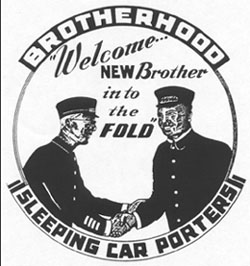
An illustration from 1934, when the Brotherhood of Sleeping Car Porters was accepted into the American Federation of Labor. / Source
When Donaldson attempted to unionize at IBM, she faced extreme antagonism within the workplace, which prompted her to file an NLRB case in spite of the broader hostile, anti-union political climate. The case was ultimately unsuccessful, leading Donaldson to leave the company.
[The Pullman Porters Union] were game because they said for a long time now they knew IBM needed to be unionized, but they couldn’t get a foot in the door. So I brought them in.
At that point, my life at IBM deteriorated to nothing. It was horrendous. And it got worse! Eventually I looked around and thought, now what do I do? And one of the Pullman Porters people said, one alternative that you have is that you can file with the National Labor Relations Board because what they’re doing is illegal — you have a case, so you should file it. Which I did.
We went through that process but didn’t get very far because this was in the 70s and I think it was Nixon coming in as President, Nixon or Reagan. Whoever was coming in as President. One promise he had made was that he would destroy people trying to take down monopolies and things like that, and he would weaken unions as much as he could.
It became clear that what IBM was doing then was dragging their feet, and the National Labor Relations Board was helping them drag their feet. I realized that nothing was going to come of it. At the end of the hearing that we had — it was kind of absurd, but at the end of the hearing I don’t remember if they didn’t make a finding or if they ruled against me. I don’t remember what the outcome was. But I know I didn’t win, and I saw what was happening with other people who were trying to unionize. And that’s how my career at IBM ended.
Donaldson sees power in archiving the work of worker-organizers, both past and present, to provide an authentic narrative of the long struggle against oppression.
Documenting what has happened and how and the people who have tried to do it and the things they have tried to do and what’s happened as a result of that — I think that’s powerful because we don’t really do that. We find somebody we want to build up into this great savior and we hold them up as fantastic heroes. And we don’t really look at their lives and what they have done and tried to do. We sort of magnify it and make it perfect.
So if what you’re doing stays on a human level and looks at what real human beings are doing and have tried to do and have fallen here and have done great over here, it puts that together as that’s who we are and how do you move from there… I don’t know if you can build from there, but at least you can understand who you are as a human being. Who we all are. And I mean, maybe given that, if we have that, that’s big.
I know I’ve done a lot, but I haven’t done a lot because I set out to do a lot. I’ve done a lot because I just wanted to be me. I wanted to use my talents. I didn’t want to have to deal with all the other stuff, but when I found it, I would fight it because that’s how I was raised.
Next week we will share excerpts from an interview with James Leas, an anti-war activist who, in the 1980s and 1990s, organized a dissident shareholders campaign to force IBM to drop its business with the South African apartheid government. If you have ideas for how to connect with more individuals in IBM Black Workers Alliance, contact me at ann@a-tbd.com.
Thank you to Kaylen Sanders, Marley Pulido Vargas, Tamara Kneese, and the TWC Newsletter team for their help editing this week’s interview.